Half Nelson - Movie Review
 Half Nelson 2006
Half Nelson 2006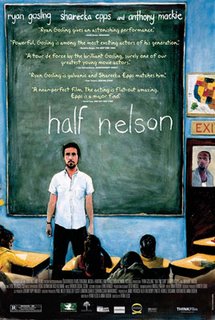 Again with the Sundance hits! And with each release, our respect for that famous Independent Film Festival dwindles. Case in point, “Half Nelson” starring cutie-Emo-angst-ridden Ryan Gosling and featuring a stunning turn by newcomer Shareeka Epps. Both of them struggle valiantly with a half written script and a director that apparently believes life should be viewed through an earthquake lens.
Again with the Sundance hits! And with each release, our respect for that famous Independent Film Festival dwindles. Case in point, “Half Nelson” starring cutie-Emo-angst-ridden Ryan Gosling and featuring a stunning turn by newcomer Shareeka Epps. Both of them struggle valiantly with a half written script and a director that apparently believes life should be viewed through an earthquake lens.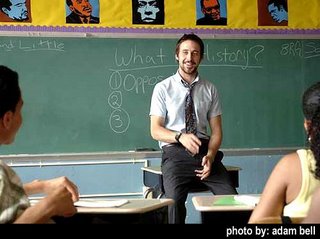 “Half Nelson” concerns the tale of Dan, a middle school history teacher by day and a crack addict by night. His inability to juggle his daily responsibilities, which include coaching the girls basketball team, with his lonely and desperate need for a little crack infused respite form the backbone of a film that hopes to be a character examination of two lonely souls reaching for something to anchor their drifting lives. It fails. But thankfully does not sink completely due to the lead performances.
“Half Nelson” concerns the tale of Dan, a middle school history teacher by day and a crack addict by night. His inability to juggle his daily responsibilities, which include coaching the girls basketball team, with his lonely and desperate need for a little crack infused respite form the backbone of a film that hopes to be a character examination of two lonely souls reaching for something to anchor their drifting lives. It fails. But thankfully does not sink completely due to the lead performances.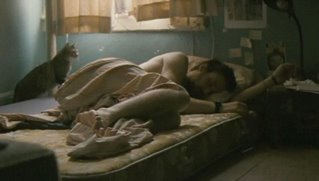 Ryan Gosling, of the graduating Mousketeer class of wannabe pop stars has turned into quite the respectable and fuckable young actor. His pull out the stops performance as a Neo-Nazi in HBO’s “The Believer” turned many heads and inspired award buzz. His underrated performance in the much underrated thriller “Murder by Numbers” as one of two teenage killers proved the boy had acting chops to spare. And with his leading man turn as the hunky loner in the drippy “The Notebook”, he insured his box office potential as a star presence. We wish him nothing but the best in his future endeavors, which is why we regret his more mannered moments in this vastly uneven flick.
Ryan Gosling, of the graduating Mousketeer class of wannabe pop stars has turned into quite the respectable and fuckable young actor. His pull out the stops performance as a Neo-Nazi in HBO’s “The Believer” turned many heads and inspired award buzz. His underrated performance in the much underrated thriller “Murder by Numbers” as one of two teenage killers proved the boy had acting chops to spare. And with his leading man turn as the hunky loner in the drippy “The Notebook”, he insured his box office potential as a star presence. We wish him nothing but the best in his future endeavors, which is why we regret his more mannered moments in this vastly uneven flick. As one of his student athletes, the young Shareeka Epps emerges as a very strong screen presence. Her on screen charisma and powerful focus are far beyond her tender years. She is not only a vibrant young actress; she is potentially a very notable actress whose future performances we await with glee. For every overwrought scene, and tasteless camera set up she emerges victorious with her no-nonsense demeanor and intensity. We believe in her character through her sheer force of will. A strength that is sorely lacking behind the camera.
As one of his student athletes, the young Shareeka Epps emerges as a very strong screen presence. Her on screen charisma and powerful focus are far beyond her tender years. She is not only a vibrant young actress; she is potentially a very notable actress whose future performances we await with glee. For every overwrought scene, and tasteless camera set up she emerges victorious with her no-nonsense demeanor and intensity. We believe in her character through her sheer force of will. A strength that is sorely lacking behind the camera.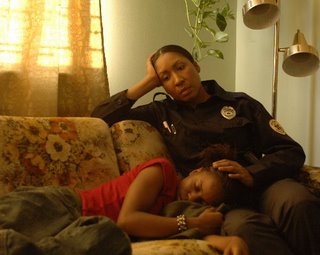 “Half Nelson” suffers greatly from the miserable, overused, and completely distracting “Hand Held Camera” technique of filmmaking that brands the director as not only a neophyte, but an unimaginative one at that. The film begins quietly with a classroom scene that resembles the viewpoint of an ice cube in a martini shaker. We were so distracted by the herky jerky camera style that we almost threw up our lunch (Which ironically, consisted of three olives from our midday martini.) attempting to focus on the characters and the situation. It didn’t help matters that the improvisatory style of dialogue was not only trite and repetitive – it failed completely to inspire interest.
“Half Nelson” suffers greatly from the miserable, overused, and completely distracting “Hand Held Camera” technique of filmmaking that brands the director as not only a neophyte, but an unimaginative one at that. The film begins quietly with a classroom scene that resembles the viewpoint of an ice cube in a martini shaker. We were so distracted by the herky jerky camera style that we almost threw up our lunch (Which ironically, consisted of three olives from our midday martini.) attempting to focus on the characters and the situation. It didn’t help matters that the improvisatory style of dialogue was not only trite and repetitive – it failed completely to inspire interest.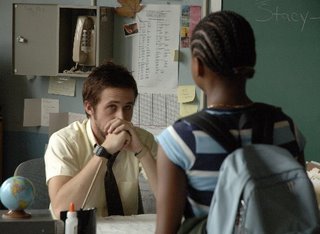 For this we must blame the filmmakers. Director Ryan Fleck, who co-penned the script with Anna Boden wants desperately to say something about the underprivileged, but what exactly that is we fail to understand. A white teacher addicted to crack, instructing history to his black students who live in drug infested neighborhoods isn’t exactly the most subtle message or situation. When the inevitable confrontation between cultures occurs, it peters out swiftly due to the complete lack of a point of view.
For this we must blame the filmmakers. Director Ryan Fleck, who co-penned the script with Anna Boden wants desperately to say something about the underprivileged, but what exactly that is we fail to understand. A white teacher addicted to crack, instructing history to his black students who live in drug infested neighborhoods isn’t exactly the most subtle message or situation. When the inevitable confrontation between cultures occurs, it peters out swiftly due to the complete lack of a point of view. We fail to empathize or sympathize with Ryan’s character, which we feel is a mistake. This film wants us to feel pity for a man who has tried and failed to pick up his life and is merely subsisting in a day to day crack haze with rare moments of clarity. But if the character lacks motivation to be anything but a drip, why should we be interested? His own attraction to his young student is based more on an uncomfortable incident that occurs after a ball game.
We fail to empathize or sympathize with Ryan’s character, which we feel is a mistake. This film wants us to feel pity for a man who has tried and failed to pick up his life and is merely subsisting in a day to day crack haze with rare moments of clarity. But if the character lacks motivation to be anything but a drip, why should we be interested? His own attraction to his young student is based more on an uncomfortable incident that occurs after a ball game. The young Drey happens to linger too long in the seemingly abandoned locker room and stumbles upon her coach and teacher, Dan stoned out of his mind in one of the bathroom stalls. This scene which is one of the turning points in the film is the only solid piece of work due completely to the performances. And here is where we lost it completely with the directorial style. For while the camera’s waiving and blurry imagery might have worked as a visual metaphor for the drugs’ influence on Dan, the mere fact that the entire film was filmed in the same manner completely negates the intended power of the scene.
The young Drey happens to linger too long in the seemingly abandoned locker room and stumbles upon her coach and teacher, Dan stoned out of his mind in one of the bathroom stalls. This scene which is one of the turning points in the film is the only solid piece of work due completely to the performances. And here is where we lost it completely with the directorial style. For while the camera’s waiving and blurry imagery might have worked as a visual metaphor for the drugs’ influence on Dan, the mere fact that the entire film was filmed in the same manner completely negates the intended power of the scene. Thankfully, the powerful exchanged glances between Drey and Dan as they lock eyes in this horrid moment of discovery almost compensate for the direction. Ryan Gosling is at his best here when he allows the fear and shame of his character to blaze through the muddled scenario. Shareeka Epps ability to project her fears and doubts matches him scene for awkward scene.
Thankfully, the powerful exchanged glances between Drey and Dan as they lock eyes in this horrid moment of discovery almost compensate for the direction. Ryan Gosling is at his best here when he allows the fear and shame of his character to blaze through the muddled scenario. Shareeka Epps ability to project her fears and doubts matches him scene for awkward scene.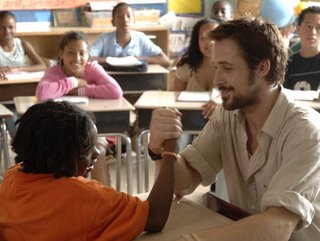 We couldn’t help imagine how powerful the film might have been under the assured hand of a talented director. For surely, one with control and taste would have been able to build a storyline out of the messy vignettes found in the script. Scene after scene, the film dribbles past any honest emotion and falls back onto pained expressions and half uttered truths, revealing absolutely nothing about its two main characters.
We couldn’t help imagine how powerful the film might have been under the assured hand of a talented director. For surely, one with control and taste would have been able to build a storyline out of the messy vignettes found in the script. Scene after scene, the film dribbles past any honest emotion and falls back onto pained expressions and half uttered truths, revealing absolutely nothing about its two main characters.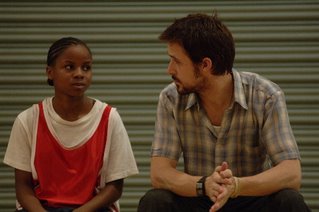 Which is an utter shame with two charismatic and talented actors such as Ryan Gosling and Shareeka Epps under contract. By the time Awards season begins to rear its greedy head, we will not be surprised at all to find both of these thespians mentioned more than once. Unfortunately, you will have to sit through this miserable little flick to actually enjoy their fleeting moments of brilliance. Bless you all!
Which is an utter shame with two charismatic and talented actors such as Ryan Gosling and Shareeka Epps under contract. By the time Awards season begins to rear its greedy head, we will not be surprised at all to find both of these thespians mentioned more than once. Unfortunately, you will have to sit through this miserable little flick to actually enjoy their fleeting moments of brilliance. Bless you all!Directed by Ryan Fleck
Written by Anna Boden & Ryan Fleck
Starring
Ryan Gosling as Dan
Shareeka Epps as Drey
Anthony Mackie as Frank
Tina Holmes as Rachel
Deborah Rush as Jo
Jay O. Sanders as Russ
Cinematography by Andrij Parekh
Film Editing by Anna Boden
Original Music by Broken-Social-Scene
Costume Design by Erin Benach
Production Design by Beth Mickle
Art Direction by Inbal Weinberg

 Oh, what to do with this tidy little thriller. On the one hand it plays so nicely in such a compact playing time that we feel we should be grateful, pass on our recommendation and leave it at that. And yet . . . and yet. But, we are getting ahead of ourselves. “The Night Listener” is based on a novel by
Oh, what to do with this tidy little thriller. On the one hand it plays so nicely in such a compact playing time that we feel we should be grateful, pass on our recommendation and leave it at that. And yet . . . and yet. But, we are getting ahead of ourselves. “The Night Listener” is based on a novel by  And so, we greet the film version of “The Night Listener” which tells the tale of Gabriel Noone portrayed with stunning understatement by the king of overstatement,
And so, we greet the film version of “The Night Listener” which tells the tale of Gabriel Noone portrayed with stunning understatement by the king of overstatement,  As it turns out, the even better story belongs to the young man in question. It seems that the child is dying from AIDS, brought upon by a youth filled with such horrifyingly brutal and sadistic torture by his parents that he is spending his final days in the secluded safety of his caretaker and foster mother figure, one Donna Logand, portrayed by the very talented
As it turns out, the even better story belongs to the young man in question. It seems that the child is dying from AIDS, brought upon by a youth filled with such horrifyingly brutal and sadistic torture by his parents that he is spending his final days in the secluded safety of his caretaker and foster mother figure, one Donna Logand, portrayed by the very talented  But not so fast, kiddies. Since Gabriel has developed such a strong feeling towards young Pete and his strong willed but obviously caring mother, Donna he is invited to visit them for the holidays. He is elated. But, soon everything seems to be going wrong. Donna keeps putting off the visits, and later the communications, declaring Pete to be too ill to receive visitors. Upon playing a message from the Logands, his ex-partner questions the veracity of the scenario. To him, the two voices sound distinctly similar, if not the same person.
But not so fast, kiddies. Since Gabriel has developed such a strong feeling towards young Pete and his strong willed but obviously caring mother, Donna he is invited to visit them for the holidays. He is elated. But, soon everything seems to be going wrong. Donna keeps putting off the visits, and later the communications, declaring Pete to be too ill to receive visitors. Upon playing a message from the Logands, his ex-partner questions the veracity of the scenario. To him, the two voices sound distinctly similar, if not the same person. Gabriel’s world is completely shaken. Does this child exist? And if not, what could possibly be the purpose of inventing such a horrific story merely to get the attention of a disembodied voice hundreds of miles away? He decides to get to the bottom of the mystery. And this is where the film either works for you or fails.
Gabriel’s world is completely shaken. Does this child exist? And if not, what could possibly be the purpose of inventing such a horrific story merely to get the attention of a disembodied voice hundreds of miles away? He decides to get to the bottom of the mystery. And this is where the film either works for you or fails. There are many things to enjoy in “The Night Listener”: first and foremost the lovely texture and mood instilled by director and co-screenwriter, Patrick Stettner. After his intriguing “
There are many things to enjoy in “The Night Listener”: first and foremost the lovely texture and mood instilled by director and co-screenwriter, Patrick Stettner. After his intriguing “ For there is a deep dark secret lurking with the Logand household, and we certainly wouldn’t want to spoil it for you, so we won’t. So there. Nyah. What we will tell you is that the film is definitely worth a visit for the three central performances which all deliver the goods.
For there is a deep dark secret lurking with the Logand household, and we certainly wouldn’t want to spoil it for you, so we won’t. So there. Nyah. What we will tell you is that the film is definitely worth a visit for the three central performances which all deliver the goods. Robin Williams has far outgrown his useful qualities as a screen comedian. One too many films like “
Robin Williams has far outgrown his useful qualities as a screen comedian. One too many films like “ As the young man in question, Rory Culkin is wonderful. Especially since his character is nothing less than an enigma. While the viewer has the opportunity to witness the quiet, graceful manner that young Rory fleshes out this tortured, nebulous creature – he will remain a mystery to our hero. We especially enjoyed Rory’s gift for playing a young man who might be dying, but has chosen not to focus on the grimmest aspect of his shortened life.
As the young man in question, Rory Culkin is wonderful. Especially since his character is nothing less than an enigma. While the viewer has the opportunity to witness the quiet, graceful manner that young Rory fleshes out this tortured, nebulous creature – he will remain a mystery to our hero. We especially enjoyed Rory’s gift for playing a young man who might be dying, but has chosen not to focus on the grimmest aspect of his shortened life. But the real acting honors must go to Toni Collette in the most divisive character in the piece. Her Donna Logand has many secrets to keep, and while we begin to understand a few of them she is far from an approachable character. This dangerously aware and emotionally fragile woman is the centerpiece of the mystery. Her tentative manner and steely bearing go a long way in selling the “trick ending” that has come to be so clichéd in all such thrillers.
But the real acting honors must go to Toni Collette in the most divisive character in the piece. Her Donna Logand has many secrets to keep, and while we begin to understand a few of them she is far from an approachable character. This dangerously aware and emotionally fragile woman is the centerpiece of the mystery. Her tentative manner and steely bearing go a long way in selling the “trick ending” that has come to be so clichéd in all such thrillers. And that is our main concern with a film that otherwise manages to avoid the obvious. While the marketing campaign telegraphs that this film was “inspired by true events”, we found most of the denouement to be completely unbelievable. Not that we necessarily crave reality in our moviemaking, which is what makes the tagline and the twist ending so unnecessary. Let us believe in the mystery of moviemaking and take us along an entertaining ride, is all we ask.
And that is our main concern with a film that otherwise manages to avoid the obvious. While the marketing campaign telegraphs that this film was “inspired by true events”, we found most of the denouement to be completely unbelievable. Not that we necessarily crave reality in our moviemaking, which is what makes the tagline and the twist ending so unnecessary. Let us believe in the mystery of moviemaking and take us along an entertaining ride, is all we ask. And certainly, for most of the film, that is blessedly what occurs. It certainly features a fine cast of actors, ably abetted by such talented folks as
And certainly, for most of the film, that is blessedly what occurs. It certainly features a fine cast of actors, ably abetted by such talented folks as  That humpy
That humpy  Co-writer and director Patrick Stettner is to be commended for his control of mood, tone and genuine fear that come in handy in some of the films more stereotypical moments. He is intelligent enough to never let the film descend into a potboiler mess. Perhaps the bumps and skids in this film are more the responsibility of the source material, but still – we were grateful for the moviegoing experience. We would feel almost guilty if we had trounced such an honest attempt at solid filmmaking. And with the performances of Robin Williams, Rory Culkin and the wonderful Toni Collette; we’re positive you'll be grateful as well. Bless you all!
Co-writer and director Patrick Stettner is to be commended for his control of mood, tone and genuine fear that come in handy in some of the films more stereotypical moments. He is intelligent enough to never let the film descend into a potboiler mess. Perhaps the bumps and skids in this film are more the responsibility of the source material, but still – we were grateful for the moviegoing experience. We would feel almost guilty if we had trounced such an honest attempt at solid filmmaking. And with the performances of Robin Williams, Rory Culkin and the wonderful Toni Collette; we’re positive you'll be grateful as well. Bless you all!
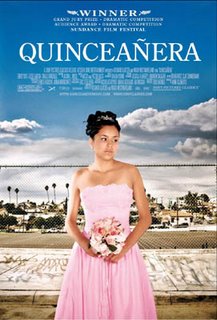 Since the dawn of cinema, filmmakers have realized one of the great potentials of the medium – porn. Hot, sweaty, cum-as-you-are, balls to the wall pornography. For decades, rumors have swirled along the back alleys of Hollywood about the existence of
Since the dawn of cinema, filmmakers have realized one of the great potentials of the medium – porn. Hot, sweaty, cum-as-you-are, balls to the wall pornography. For decades, rumors have swirled along the back alleys of Hollywood about the existence of 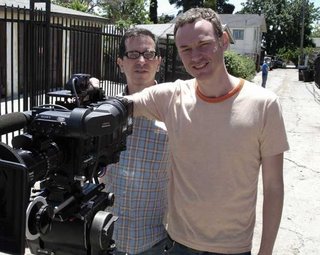 And what has this to do with the latest Grand Jury Prize winner to come from the prestigious
And what has this to do with the latest Grand Jury Prize winner to come from the prestigious  And we couldn’t be happier for them. Well, within reason. As those of you not gifted in the Castilian tongue might not know, a “
And we couldn’t be happier for them. Well, within reason. As those of you not gifted in the Castilian tongue might not know, a “ We are introduced to fourteen year old Magdalena, played by the lovingly real Emily Rios as she helps celebrate her cousin’s Quinceañera with her extended family and friends. The party is disrupted by the unexpected arrival of her ostracized cousin, Carlos portrayed winningly by Jesse Garcia. Ay Chihuahua! What a little
We are introduced to fourteen year old Magdalena, played by the lovingly real Emily Rios as she helps celebrate her cousin’s Quinceañera with her extended family and friends. The party is disrupted by the unexpected arrival of her ostracized cousin, Carlos portrayed winningly by Jesse Garcia. Ay Chihuahua! What a little  Meanwhile, back at el Rancho, Magdalena has problems of her own. Her teenage passion for on / off boyfriend, Herman has seemingly resulted in a quite unplanned for pregnancy. And being the daughter of a preacher, this hardly sits well once the gato is out of the bag. Before the mierda can fully hit the fan, she runs to the safe embrace of her great-great-uncle, Tio Tomas played with a wonderful authenticity by veteran character actor Chalo González. She is not the only one. For Tio Tomas has also taken in the unwanted Carlos.
Meanwhile, back at el Rancho, Magdalena has problems of her own. Her teenage passion for on / off boyfriend, Herman has seemingly resulted in a quite unplanned for pregnancy. And being the daughter of a preacher, this hardly sits well once the gato is out of the bag. Before the mierda can fully hit the fan, she runs to the safe embrace of her great-great-uncle, Tio Tomas played with a wonderful authenticity by veteran character actor Chalo González. She is not the only one. For Tio Tomas has also taken in the unwanted Carlos.  And while this could easily have become a Mexican American version of “
And while this could easily have become a Mexican American version of “ As the film unspools, we had a few reservations. The romance angle between Magdalena and Herman plays uncomfortably like a slightly saucier “
As the film unspools, we had a few reservations. The romance angle between Magdalena and Herman plays uncomfortably like a slightly saucier “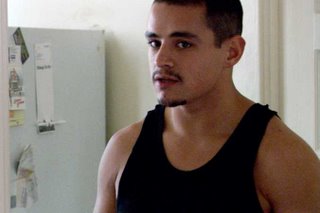 The subplot of Carlos becoming embroiled in a ménage a trois with the A-list gays who are also this thrown together family’s landlords is a tad Gay Porn lite. (All they were missing were two hot mechanics arriving to fix the car or a muscle bound hitchhiker getting lost on his way to
The subplot of Carlos becoming embroiled in a ménage a trois with the A-list gays who are also this thrown together family’s landlords is a tad Gay Porn lite. (All they were missing were two hot mechanics arriving to fix the car or a muscle bound hitchhiker getting lost on his way to  Chalo González has been working in films for near forty years, in fine company too with the legendary
Chalo González has been working in films for near forty years, in fine company too with the legendary 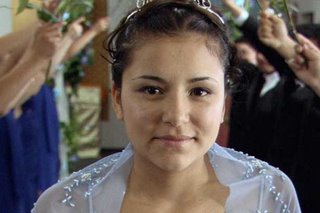 As Magdalena, the young Emily Rios does a fine job of appearing to be real teenager. One without guile or pretense. In many ways this is her story, and she helps center the film with a realism that most actresses would kill for.
As Magdalena, the young Emily Rios does a fine job of appearing to be real teenager. One without guile or pretense. In many ways this is her story, and she helps center the film with a realism that most actresses would kill for.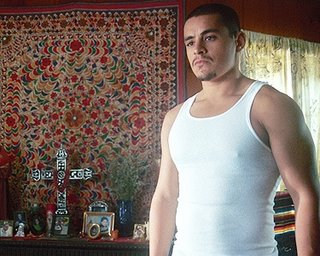 And as the humpy young gay car wash attendee (Nice - well did you expect him to be a stockbroker?), Jesse Garcia surprised us by rising to the occasion. (Again with the filthy minds. You should be ashamed of yourselves!) For despite his being the elder cousin, his character is perhaps the most naïve of the duo. His hopeless romance with one of the landlords turns quite sour, and forces a drastic change in the lives of the trio. When tragedy strikes, it is Carlos who must end up holding the family together while finally admitting his own vulnerability. It is a lovely performance for this young actor, made even lovelier by his smoldering sexuality. (There. Now you can let loose with the drooling and panting.)
And as the humpy young gay car wash attendee (Nice - well did you expect him to be a stockbroker?), Jesse Garcia surprised us by rising to the occasion. (Again with the filthy minds. You should be ashamed of yourselves!) For despite his being the elder cousin, his character is perhaps the most naïve of the duo. His hopeless romance with one of the landlords turns quite sour, and forces a drastic change in the lives of the trio. When tragedy strikes, it is Carlos who must end up holding the family together while finally admitting his own vulnerability. It is a lovely performance for this young actor, made even lovelier by his smoldering sexuality. (There. Now you can let loose with the drooling and panting.) We found ourselves surprisingly moved by this quiet little flick, and understand how it took both honors at Sundance. But we would be remiss in our duties if we didn’t digress for a moment and admit more than little disappointment. For while the direction is uniformly fine, employing a blessedly spare roving camera and tight handheld work. The script remains far too thin and reliant on a particular brand of homespun charm that it fails to reach throughout the first half.
We found ourselves surprisingly moved by this quiet little flick, and understand how it took both honors at Sundance. But we would be remiss in our duties if we didn’t digress for a moment and admit more than little disappointment. For while the direction is uniformly fine, employing a blessedly spare roving camera and tight handheld work. The script remains far too thin and reliant on a particular brand of homespun charm that it fails to reach throughout the first half. It is up to the non-professional skills of Emily Rios and Jesse Garcia to help ground the flick, and thankfully they are up to the task. The various peripheral characters are handled in a believable fashion – particularly with the nice low key banter between the young teenage girls – but never quite ignite our interest. And if we are to truly care for the plight of the abandoned cousins, we must be able to rejoice in their eventual survival. A survival that is wholly dependent on the reconciliation with their extended families.
It is up to the non-professional skills of Emily Rios and Jesse Garcia to help ground the flick, and thankfully they are up to the task. The various peripheral characters are handled in a believable fashion – particularly with the nice low key banter between the young teenage girls – but never quite ignite our interest. And if we are to truly care for the plight of the abandoned cousins, we must be able to rejoice in their eventual survival. A survival that is wholly dependent on the reconciliation with their extended families. The film works visually, in a very polished low budget way. The closing scene is certainly not unexpected, but handled very well. It is a tribute to the young leads and the grace and charm of the old veteran Chalo González, that we can recommend this film. It creeps up on you and leaves a mark. Much like the director duos more infamous Bluer works behind the camera. And hey, if this film isn’t their ticket to the mainstream – at least they know how to film a
The film works visually, in a very polished low budget way. The closing scene is certainly not unexpected, but handled very well. It is a tribute to the young leads and the grace and charm of the old veteran Chalo González, that we can recommend this film. It creeps up on you and leaves a mark. Much like the director duos more infamous Bluer works behind the camera. And hey, if this film isn’t their ticket to the mainstream – at least they know how to film a 
